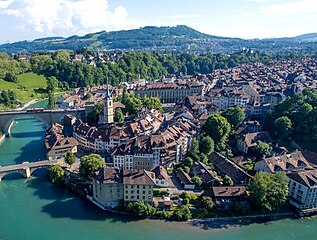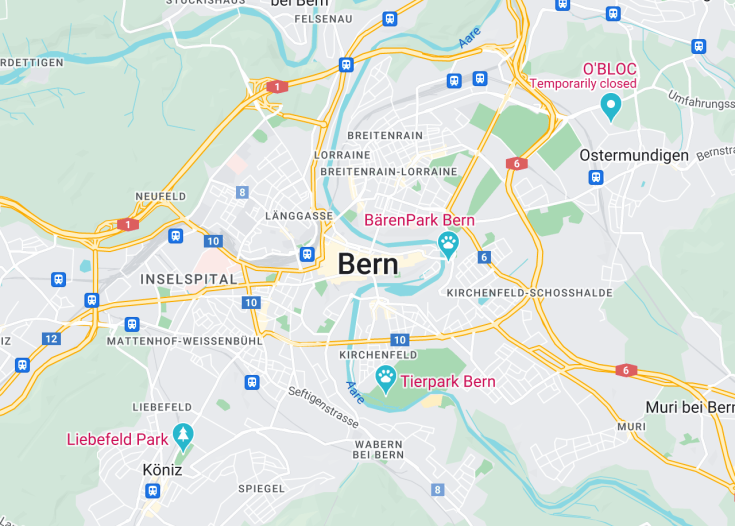Bern, the capital of Switzerland, offers a unique blend of historical charm and contemporary vibrancy. This UNESCO World Heritage site enchants with its well-preserved medieval city center, home to the famous Zytglogge clock tower and the towering Bundeshaus, which houses the Swiss Federal Parliament. The Aare River adds to the city’s picturesque setting, making Bern an essential destination for culture, history, and nature lovers. Its museums, galleries, and cultural events reflect a rich heritage and innovative spirit.
Explore the Rose Garden for a splendid view of the old town and the Alps beyond. It’s the perfect spot for both relaxation and taking memorable photos.
Don’t miss a guided tour of the Bundeshaus; it provides insightful glimpses into Swiss political life and offers access to impressive halls not usually open to the public.
Bern: A Cultural Heart in Switzerland
| Country | Switzerland |
| Time in Bern | GMT+1 |
| Language spoken | German |
| Population | 133,798 (Source: City Population, 2022) |
| Currency | Swiss Franc (CHF, ₣) |
| Airports |
|
Bern, the capital city of Switzerland, holds a prominent place in both the political and cultural landscapes of the country. Known for its well-preserved medieval city center, a UNESCO World Heritage Site, Bern offers a unique blend of history, culture, and modernity. The city is defined by its iconic Zytglogge, an ancient clock tower with moving puppets, and its sandstone facades stretching across the old town. Frequent cultural events, museums, and galleries enrich the city’s vibrant life. The Kunstmuseum, housing works by Paul Klee, Pablo Picasso, and Ferdinand Hodler, is a highlight for art lovers. Historically, Bern has been a hub for the trade with several traditional markets still operating in the city center. The Federal Palace of Switzerland, home to the Swiss National Parliament, underscores Bern’s role as the political center of Switzerland. Green spaces such as the Rosengarten overlook the river Aare, providing stunning views of the old town and ample opportunities for relaxation and recreation. With a strong educational infrastructure, including the University of Bern, the city is also a pinnacle for research and academia. Its strategic location and quality of life make it a magnet for both tourists and professionals. Bern’s culinary scene offers a mix of international cuisines and local Swiss dishes, particularly cheese and chocolate, which are integral to Swiss culture.
Where is Bern?
Bern is situated in the central part of Switzerland, nestled in a loop of the Aare River.
Distances:
| Route | Distance by car | Time by car |
|---|---|---|
| Zürich to Bern | 75 mi (121 km) | 1h 20min |
| Geneva to Bern | 99 mi (159 km) | 1h 40min |
| Basel to Bern | 50 mi (81 km) | 1h |
What is Bern famous for?
Bern is most famous for its historical sites including the Zytglogge, the Federal Palace, and its well-preserved medieval cityscape that is a UNESCO World Heritage site.
History
Before 1191: Early Settlements
The region around Bern was inhabited by the Helvetii tribe before the Roman era, suggesting a sparse population engaged primarily in agriculture and trading. Evidence from archaeological digs reveals traces of these early settlements scattered across the area.
1191-1353: Foundation and Expansion
Bern was officially founded in 1191 by Duke Berthold V of Zähringen. Legend has it that the city was named after a bear (“Bär” in German) that the Duke had killed during a hunt, an emblem still evident in the city’s coat of arms. Following the extinction of the Zähringen dynasty, Bern became a Free Imperial City in 1218 under the Holy Roman Empire. The city expanded rapidly, establishing itself as a key center of trade and commerce, and built its iconic Zytglogge, an astronomical clock tower, during this period.
1353-1798: Membership in the Swiss Confederacy
In 1353, Bern joined the Swiss Confederacy, a crucial alliance that marked its rise to political prominence. During the Burgundian Wars, it expanded its territory significantly and became one of Europe’s largest city-states north of the Alps. The city’s university, founded in 1834, became a hub of Enlightenment scholarship.
1798-1848: Napoleonic Era and Restoration
Bern was occupied by French troops in 1798 during the Napoleonic Wars. Following the collapse of the Napoleonic Empire, the Congress of Vienna recognized Bern as the Federal City in 1815, and it became de facto capital of the Swiss Confederation in 1848, with the first sessions of the Swiss Federal Assembly convening here.
Modern Day
Today, Bern is not only the political center of Switzerland but also a cultural hub, with several museums, galleries, and historical sites. The medieval city center of Bern is a UNESCO World Heritage Site, and the city is known for maintaining its historical heritage while integrating modernity smoothly.
Visit Bern
What to see and do in Bern
Bern, the capital city of Switzerland, offers a splendid blend of historical sites, vibrant cultural offerings, and lush nature. Key attractions include:
- The Zytglogge: An ancient clock tower with an impressive astronomical clock from the early 15th century, which is one of the city’s most famous landmarks.
- The Federal Palace (Bundeshaus): The seat of Switzerland’s government, offering guided tours to learn about Switzerland’s political system.
- Bern Historical Museum: The second-largest historical museum in Switzerland, offering insights into Bern’s history from its foundations to modern days.
- Rosengarten: A park offering panoramic views of the old town center and a collection of over 200 types of roses.
Events in Bern
Bern hosts a variety of events throughout the year, including:
- Bern Jazz Festival: Held annually in March, this event attracts jazz enthusiasts from all over the world.
- Onion Market (Zibelemärit): A traditional folk festival celebrated on the fourth Monday in November, featuring onion-themed products, crafts, and festivities.
Best time to visit Bern
The ideal time to visit Bern is between May and September when the weather is pleasant, and the city’s gardens and outdoor spaces are in full bloom. However, winter also offers a particular charm, especially around Christmas when the city is festively decorated.
Is Bern worth visiting?
Bern is undoubtedly worth visiting for its unique blend of history, culture, and natural beauty. The well-preserved medieval city center, recognized as a UNESCO World Heritage Site, offers a journey through time. Coupled with modern conveniences and surrounded by stunning Swiss landscapes, Bern provides a balanced experience for both history buffs and nature lovers. Whether for a quick stop or a longer stay, Bern invites visitors to explore its many treasures.









